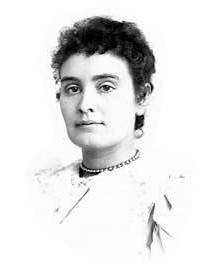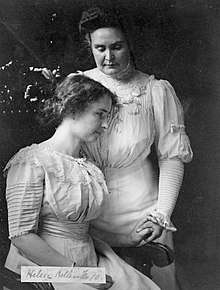Anne Sullivan
Anne Sullivan Macy (born Johanna Mansfield Sullivan; April 14, 1866 – October 20, 1936) was an American teacher best known for being the instructor and lifelong companion of Helen Keller.[1]
Anne Sullivan | |
|---|---|
 Sullivan in 1887 | |
| Born | Johanna Mansfield Sullivan April 14, 1866 |
| Died | October 20, 1936 (aged 70) Forest Hills, Queens, New York, U.S. |
| Resting place | Washington National Cathedral |
| Spouse(s) | John Albert Macy (1905–1932) |
At the age of five, Sullivan contracted trachoma, an eye disease, which left her partially blind and without reading or writing skills.[2] She received her education as a student of the Perkins School for the Blind; soon after graduation at age 20, she became a teacher to Keller.[2]
Childhood
Sullivan was born on April 14, 1866, in Feeding Hills, Agawam, Massachusetts. According to her baptismal certificate, her name at birth was Johanna Mansfield Sullivan; however, she was called Anne or Annie from birth.[3] She was the oldest child of Thomas and Alice (Cloesy) Sullivan, who emigrated to the United States from Ireland during the Great Famine.[2]
When she was five years old, Sullivan contracted a bacterial eye disease known as trachoma, which caused many painful infections and, over time, made her nearly blind.[2] When she was eight, her mother died from tuberculosis, and her father abandoned the children two years later for fear he could not raise them on his own.[2] She and her younger brother, James (Jimmie), were sent to the run-down and overcrowded almshouse in Tewksbury, Massachusetts, today part of Tewksbury Hospital, and their younger sister, Mary, was left to an aunt. Jimmie had a weak hip condition and then died from tuberculosis four months into their stay. Anne remained at Tewksbury after his death and endured two unsuccessful eye operations.
Due to reports of cruelty to inmates at Tewksbury, including sexually perverted practices and cannibalism, the Massachusetts Board of State Charities launched an investigation into the institution in 1875.[4]. The investigation was led by Franklin Benjamin Sanborn, then chairman of the board, and Samuel Gridley Howe, founder of the Perkins School for the Blind in Boston.
In February 1877, Anne was sent to the Soeurs de la Charite hospital in Lowell, Massachusetts, where she had another unsuccessful operation. Remaining there, she helped the nuns in the wards and went on errands in the community until July of that year when she was sent to the city infirmary, where she had one more unsuccessful operation, and was then transferred back to Tewksbury under duress.[4] Instead of returning to the facility for predominantly ill and insane patients, she was housed with single mothers and unmarried pregnant women.
During a subsequent inspection of Tewksbury in 1880 by Franklin Benjamin Sanborn, now State Inspector of Charities, Anne beseeched him to allow her to be admitted to the Perkins School for the Blind. Within months, her plea was granted.[4].
Education

Anne began her studies at the Perkins School on October 7, 1880.[2] Although her rough manners made her first years at Perkins humiliating for her, she managed to connect with a few teachers and made progress with her learning.[2] While there, she befriended and learned the manual alphabet from Laura Bridgman, a graduate of Perkins and the first blind and deaf person to be educated there. Also while there, she had a series of eye operations that significantly improved her vision.[3] In June 1886, she graduated at age 20 as the valedictorian of her class. She stated "Fellow-graduates: Duty bids us go forth into active life. Let us go cheerfully, hopefully, and earnestly, and set ourselves to find our especial part. When we have found it, willingly and faithfully perform it; for every obstacle we overcome, every success we achieve tends to bring man closer to God and make life more as He would have it."[2]
Career

The summer following Sullivan's graduation, the director of Perkins, Michael Anagnos, was contacted by Arthur Keller, who was in search of a teacher for his seven-year-old blind and deaf daughter, Helen.[2] Anagnos immediately recommended Sullivan for this position, and she began her work on March 3, 1887, at the Kellers' home in Tuscumbia, Alabama.[2] As soon as she arrived there, she argued with Helen's parents about the Civil War and over the fact that they used to own slaves.[5] However, she also quickly connected with Helen. It was the beginning of a 49-year relationship: Sullivan evolved from teacher, to governess, and finally to companion and friend.[6]

Sullivan's curriculum involved a strict schedule with constant introduction of new vocabulary words; however, Sullivan quickly changed her teachings after seeing they did not suit Keller.[2] Instead, she began to teach her vocabulary based on her own interests, by spelling each word out into Keller's palm;[7] within six months this method proved to be working, as Keller had learned 575 words, some multiplication tables, and the Braille system.[2] Sullivan strongly encouraged Helen's parents to send her to the Perkins School, where she could have an appropriate education. Once they agreed to this, Sullivan took Keller to Boston in 1888 and stayed with her there. Sullivan continued to teach her bright protégée, who soon became famous for her remarkable progress.[8] With the help of the school's director Anagnos, Keller became a public symbol for the school, helping to increase its funding and donations and making it the most famous and sought-after school for the blind in the country. However, an accusation of plagiarism against Keller greatly upset Sullivan: she left and never returned, but did remain influential to the school.[2] Sullivan also remained a close companion to Keller and continued to assist in her education, which ultimately included a degree from Radcliffe College.
Personal life

On May 3, 1905, Sullivan married Harvard University instructor and literary critic John Albert Macy (1877–1932), who had helped Keller with her publications.[9] When she married, Sullivan was already living with Keller as her personal teacher, so Macy moved into the household of both women. However, within a few years, the marriage began to disintegrate. By 1914, they separated, though he is listed as living as a "lodger" with them in the 1920 U.S. Census.[10] As the years progressed after their separation, Macy appears to have faded from her life, and the two never officially divorced. Sullivan never remarried.
Awards
In 1932, Keller and Sullivan were each awarded honorary fellowships from the Educational Institute of Scotland. They were also awarded honorary degrees from Temple University.[11] In 1955, Keller was awarded an honorary degree from Harvard University,[9] and in 1956, the director's cottage at the Perkins School was named the Keller-Macy Cottage.[2]
In 2003, Sullivan was inducted into the National Women's Hall of Fame.[12]
Death
Sullivan had been seriously visually impaired for almost all of her life, but by 1935, she was completely blind in both eyes. On October 15, 1936, she had a coronary thrombosis, fell into a coma, and died five days later, on October 20,[13] at the age of 70 in the Forest Hills neighborhood of Queens, New York, with Keller holding her hand.[14] Keller described Sullivan's last month as being very agitated, but during the last week, she was said to return to her normal generous self.[15] Sullivan was cremated and her ashes interred in a memorial at the National Cathedral in Washington, D.C.[16] She was the first woman to be recognized for her achievements in this way. When Keller died in 1968, her ashes were placed next to those of her teacher’s Sullivan.
Media representation
Sullivan is the main character in The Miracle Worker by William Gibson, originally produced for television in 1957, in which she was portrayed by Teresa Wright.[17] The Miracle Worker then moved to Broadway and later was produced as a 1962 feature film. Both the play and the film featured Anne Bancroft as Sullivan.[18] Patty Duke, who played Keller on Broadway and in the 1962 film, later played Sullivan in a 1979 television remake.[19] Roma Downey portrayed her in the TV movie Monday After the Miracle (1998).[20] Alison Elliott portrayed her in a 2000 television movie.[21] Alison Pill played her on Broadway in the short-lived 2010 revival, with Abigail Breslin as Keller.
References
- Herrmann, Dorothy. Helen Keller: A Life, Alfred A. Knopf, New York, 1998, p. 35; ISBN 0-679-44354-1
- McGinnity, Seymour-Ford, & Andries, 2014
- "Anne Sullivan Macy Biography". April 2, 2018. Archived from the original on April 2, 2018.
- "A Brief Exit from Tewksbury - Anne's Formative Years (1866-1886) - Helen Keller Kids Museum". braillebug.org.
- Kim E. Nielsen, The radical lives of Hellen Keller, Year: 2007, c2004, New York University Press
- The life of Helen Keller Archived December 31, 2012, at the Wayback Machine, Royal National Institute of Blind People, last updated August 14, 2012. Retrieved December 30, 2012.
- "Teaching Helen - Anne as Teacher (1886-1904)". www.afb.org. Archived from the original on 2019-02-28. Retrieved 2019-02-27.
- Wallace, Arminta. "Anne Sullivan, the Irish-American who taught Helen Keller to speak". The Irish Times. Retrieved 2019-02-27.
- Lash, 1980
- In the 1920 census, Keller was 38 years old and listed as head of her household in Queens, New York. Sullivan, age 52, is listed as living with her as a private teacher. John, age 44, is also listed as living with them, as a "lodger", with the occupation of writer/author.
- Herrmann, pp. 252–53
- "Anne Sullivan (Anne Sullivan Macy)". National Women’s Hall of Fame.
- Nielsen, p. 266
- Herrmann, p. 255.
- Nielsen, p. 266.
- Wilson, Scott. Resting Places: The Burial Sites of More Than 14,000 Famous Persons, 3rd ed.: 2 (Kindle Locations 24972–24974). McFarland & Company, Inc., Publishers. Kindle edition.
- Teresa Wright (I) on IMDb
- Anne Bancroft (I) on IMDb
- Patty Duke on IMDb
- "Roma Downey also stars in CBS movie `Miracle'". Deseret News. November 15, 1998.
- Alison Elliott (I) on IMDb
- Tewksbury Almshouse patient records
- McGinnity, B. L., J. Seymour-Ford, and K. J. Andries. "Anne Sullivan". Perkins School for the Blind. February 14, 2014. Accessed February 14, 2014. Anne Sullivan.
- Lash, Joseph (1980). Helen and teacher: the story of Helen Keller and Anne Sullivan Macy. New York: Delacorte Press. ISBN 9780440036548.
- Nielsen, Kim E. Beyond the Miracle Worker: the Remarkable Life of Anne Sullivan Macy and Her Extraordinary Friendship with Helen Keller. Beacon Press, 2010.
Further reading
- Delano, Marfe Ferguson (2008). Helen's Eyes: A Photobiography of Annie Sullivan, Helen Keller's Teacher. National Geographic Books. ISBN 978-1-4263-0209-1.
- Miller, Sarah (2007). Miss Spitfire: Reaching Helen Keller. Atheneum. ISBN 1-4169-2542-2.
- Keller, Helen (1955). Teacher, Anne Sullivan Macy: A Tribute by the Foster Child of Her Mind. Doubleday.
- Braddy, Nella (1933). Anne Sullivan Macy: The Story Behind Helen Keller. Doubleday, Doran & Company.
External links
| Library resources about Anne Sullivan |
| By Anne Sullivan |
|---|
| Wikimedia Commons has media related to Anne Sullivan. |
- Anne Sullivan Macy: Miracle Worker, a multimedia museum from the American Foundation for the Blind
- Works by Annie Sullivan at Project Gutenberg
- Works by or about Anne Sullivan at Internet Archive
- Helen Keller Kids Museum Online
- Helen Keller and Anne Sullivan Archive at Perkins School for the Blind
- "Anne Sullivan". Educator. Find a Grave. January 1, 2001. Retrieved August 18, 2011.
